高级隐喻词汇
- 格式:doc
- 大小:26.50 KB
- 文档页数:3
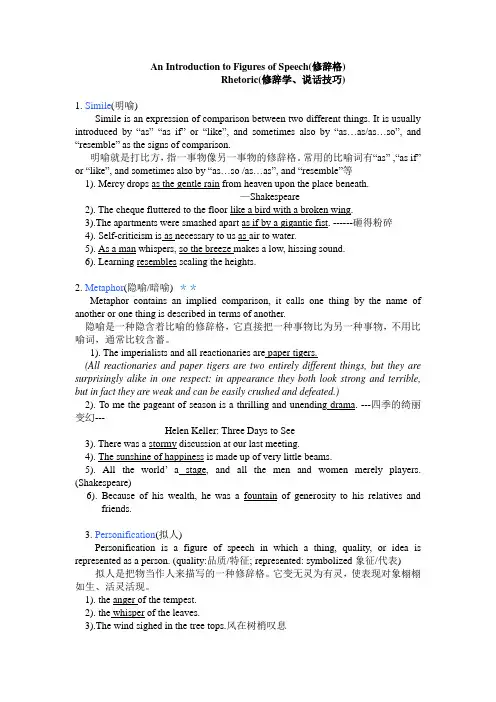
An Introduction to Figures of Speech(修辞格)Rhetoric(修辞学、说话技巧)1.Simile(明喻)Simile is an expression of comparison between two different things. It is usually introduced by “as”“as if”or “like”, and sometimes also by “as…as/as…so”, and “resemble” as the signs of comparison.明喻就是打比方,指一事物像另一事物的修辞格。
常用的比喻词有“as” ,“as if”or “like”, and sometimes also by “as…so /as…as”, and “resemble”等1). Mercy drops as the gentle rain from heaven upon the place beneath. —Shakespeare2). Thecheque fluttered to the floor like a bird with a broken wing.3).The apartments were smashed apart as if by a gigantic fist. ------砸得粉碎4). Self-criticism is as necessary to us as air to water.5). As a man whispers, so the breeze makes a low, hissing sound.6). Learning resembles scaling the heights.2. Metaphor(隐喻/暗喻)**Metaphor contains an implied comparison, it calls one thing by the name of another or one thing is described in terms of another.隐喻是一种隐含着比喻的修辞格,它直接把一种事物比为另一种事物,不用比喻词,通常比较含蓄。
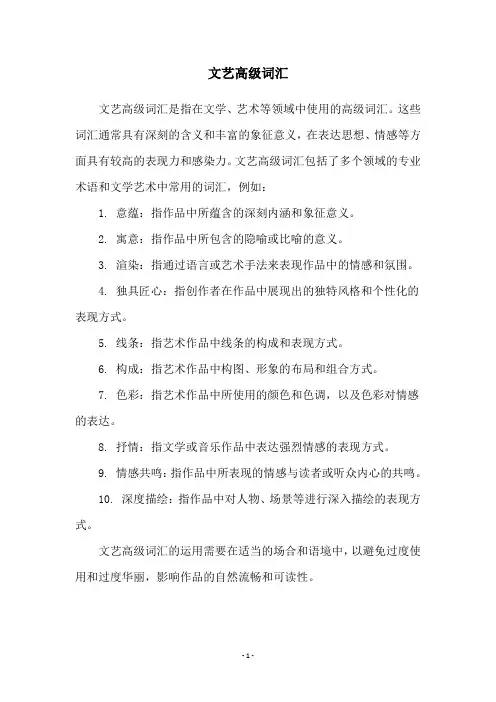
文艺高级词汇
文艺高级词汇是指在文学、艺术等领域中使用的高级词汇。
这些词汇通常具有深刻的含义和丰富的象征意义,在表达思想、情感等方面具有较高的表现力和感染力。
文艺高级词汇包括了多个领域的专业术语和文学艺术中常用的词汇,例如:
1. 意蕴:指作品中所蕴含的深刻内涵和象征意义。
2. 寓意:指作品中所包含的隐喻或比喻的意义。
3. 渲染:指通过语言或艺术手法来表现作品中的情感和氛围。
4. 独具匠心:指创作者在作品中展现出的独特风格和个性化的表现方式。
5. 线条:指艺术作品中线条的构成和表现方式。
6. 构成:指艺术作品中构图、形象的布局和组合方式。
7. 色彩:指艺术作品中所使用的颜色和色调,以及色彩对情感的表达。
8. 抒情:指文学或音乐作品中表达强烈情感的表现方式。
9. 情感共鸣:指作品中所表现的情感与读者或听众内心的共鸣。
10. 深度描绘:指作品中对人物、场景等进行深入描绘的表现方式。
文艺高级词汇的运用需要在适当的场合和语境中,以避免过度使用和过度华丽,影响作品的自然流畅和可读性。
- 1 -。
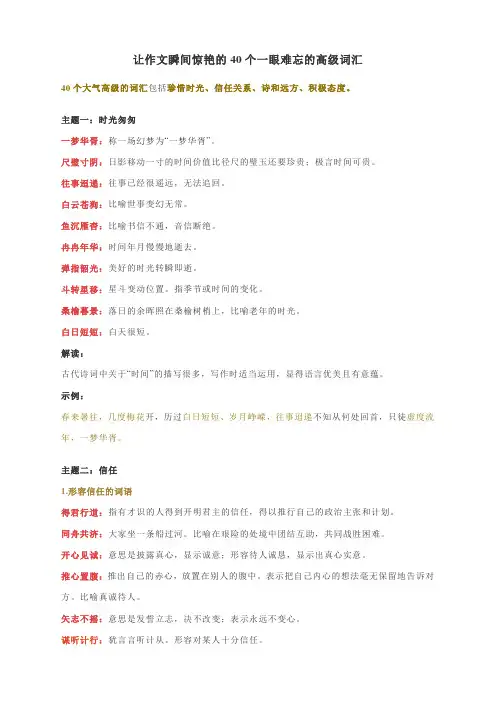
让作文瞬间惊艳的40个一眼难忘的高级词汇40个大气高级的词汇包括珍惜时光、信任关系、诗和远方、积极态度。
主题一:时光匆匆一梦华胥:称一场幻梦为“一梦华胥”。
尺璧寸阴:日影移动一寸的时间价值比径尺的璧玉还要珍贵;极言时间可贵。
往事迢递:往事已经很遥远,无法追回。
白云苍狗:比喻世事变幻无常。
鱼沉雁杳:比喻书信不通,音信断绝。
冉冉年华:时间年月慢慢地逝去。
弹指韶光:美好的时光转瞬即逝。
斗转星移:星斗变动位置。
指季节或时间的变化。
桑榆暮景:落日的余晖照在桑榆树梢上,比喻老年的时光。
白日短短:白天很短。
解读:古代诗词中关于“时间”的描写很多,写作时适当运用,显得语言优美且有意蕴。
示例:春来暑往,几度梅花开,历过白日短短、岁月峥嵘,往事迢递不知从何处回首,只徒虚度流年,一梦华胥。
主题二:信任1.形容信任的词语得君行道:指有才识的人得到开明君主的信任,得以推行自己的政治主张和计划。
同舟共济:大家坐一条船过河。
比喻在艰险的处境中团结互助,共同战胜困难。
开心见诚:意思是披露真心,显示诚意;形容待人诚恳,显示出真心实意。
推心置腹:推出自己的赤心,放置在别人的腹中。
表示把自己内心的想法毫无保留地告诉对方。
比喻真诚待人。
矢志不摇:意思是发誓立志,决不改变;表示永远不变心。
谋听计行:犹言言听计从。
形容对某人十分信任。
示例:信任如书,其中的奥义非三言两语可道尽,它是人与人之间一切情感联系的基础。
信任是在患难中团结成共同体,在风雨飘摇中同舟共济,荣辱与共。
信任需要一片真心,一份真诚,需要推心置腹的交流,但也不意味着过度信任,谋听计行。
2.形容失去信任的词语杯弓蛇影:有人请客吃饭,挂在墙上的弓映在酒杯里,客人以为酒杯里有蛇,回去疑心中了蛇毒,就生病了。
比喻疑神疑鬼,妄自惊慌。
刚愎自用:不接受别人的意见,独断专行。
固执己见:顽固坚持自己的意见,不肯改变。
风声鹤唳:形容惊慌失措,或自相惊忧。
草木皆兵:把山上的草木都当做敌兵。
形容人在惊慌时疑神疑鬼。
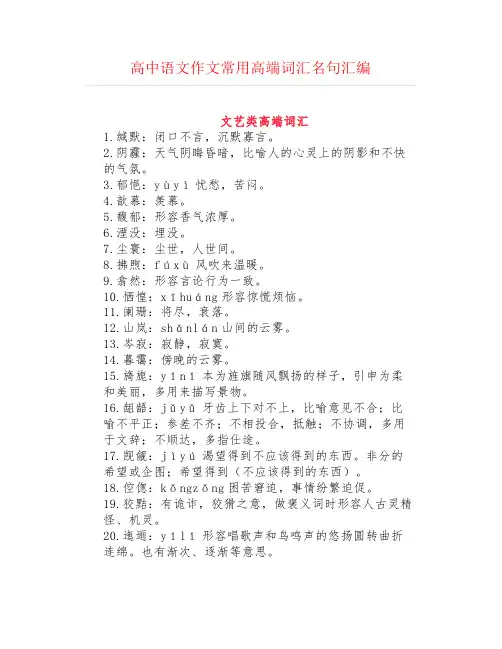
高中语文作文常用高端词汇名句汇编文艺类高端词汇1.缄默:闭口不言,沉默寡言。
2.阴霾:天气阴晦昏暗,比喻人的心灵上的阴影和不快的气氛。
3.郁悒:yùyì忧愁,苦闷。
4.歆慕:羡慕。
5.馥郁:形容香气浓厚。
6.湮没:埋没。
7.尘寰:尘世,人世间。
8.拂煦:fúxù风吹来温暖。
9.翕然:形容言论行为一致。
10.恓惶:xīhuáng形容惊慌烦恼。
11.阑珊:将尽,衰落。
12.山岚:shānlán山间的云雾。
13.岑寂:寂静,寂寞。
14.暮霭:傍晚的云雾。
15.旖旎:yǐnǐ本为旌旗随风飘扬的样子,引申为柔和美丽,多用来描写景物。
16.龃龉:jǔyǔ牙齿上下对不上,比喻意见不合;比喻不平正;参差不齐;不相投合,抵触;不协调,多用于文辞;不顺达,多指仕途。
17.觊觎:jìyú渴望得到不应该得到的东西。
非分的希望或企图;希望得到(不应该得到的东西)。
18.倥偬:kǒngzǒng困苦窘迫,事情纷繁迫促。
19.狡黠:有诡诈,狡猾之意,做褒义词时形容人古灵精怪、机灵。
20.迤逦:yǐlǐ形容唱歌声和鸟鸣声的悠扬圆转曲折连绵。
也有渐次、逐渐等意思。
21.伶俜:língpīng孤单,孤独,孤立,飘泊,流离,引申指残落,凋零,艰难。
22.乖戾:(性情、言语、行为)别扭,不合情理,原意乖悖违戾,抵触而不一致。
23.褴褛:指衣服破烂,不整洁,十分凌乱,不堪入目。
24.执拗:形容固执任性,坚持己见,听不进别人的意见。
也有阻拦的意思。
25.纨绔:富贵人家子弟穿的细绢做成的裤子,泛指有钱人家子弟的华美衣着,借指富贵人家的子弟。
26.饕餮:原指传说中的凶恶贪食的野兽,比喻贪婪之徒。
27.徜徉:彷徨,心神不宁;陶醉于某事物当中。
28.趔趄:lièqie由于某种原因,身体歪斜,脚步不稳。
29.睥睨:pìnì斜视。
有厌恶、傲慢等意。

经济类英语文本中隐喻的汉译1. "The economy is a roller coaster."(经济就像过山车。
)这个隐喻将经济比喻为过山车,暗示经济波动不定,有高有低。
2. "Inflation is a ticking time bomb."(通货膨胀是一颗定时炸弹。
)这个隐喻将通货膨胀比喻为定时炸弹,暗示通胀问题可能在任何时候爆发。
3. "The stock market is a casino."(股市就像赌场。
)这个隐喻将股市比喻为赌场,暗示投资股市存在风险和不确定性。
4. "His idea was a gold mine."(他的想法是一座金矿。
)这个隐喻将某人的想法比喻为金矿,暗示这个想法非常有价值和有利可图。
5. "The company is sailing in troubled waters."(公司正处于动荡的水域中航行。
)这个隐喻将公司比喻为在动荡的水域中航行,暗示公司面临困难和挑战。
6. "The government is tightening its belt."(政府在勒紧裤腰带。
)这个隐喻将政府比喻为在勒紧裤腰带,暗示政府在削减开支和控制财政状况。
7. "The market is a battlefield."(市场是一个战场。
)这个隐喻将市场比喻为战场,暗示竞争激烈,参与者需要战胜对手才能获得成功。
8. "The economy is a house of cards."(经济就像一座纸牌屋。
)这个隐喻将经济比喻为纸牌屋,暗示经济脆弱,可能随时崩塌。
以上是一些经济类英语文本中常见的隐喻的汉译示例。
请注意,隐喻的译文可能根据具体语境和意图而有所不同。
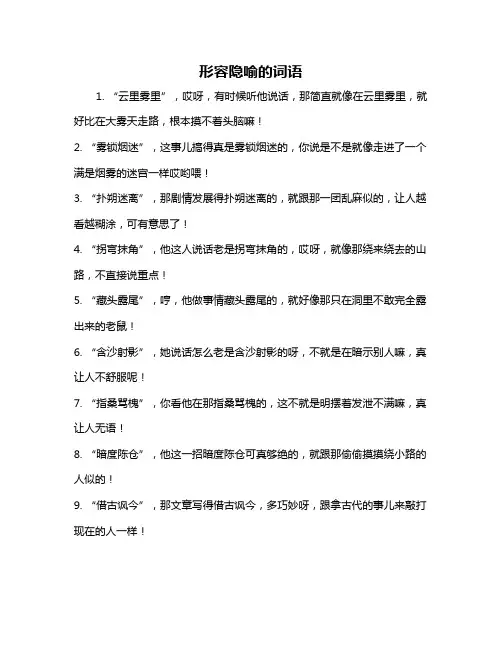
形容隐喻的词语
1. “云里雾里”,哎呀,有时候听他说话,那简直就像在云里雾里,就好比在大雾天走路,根本摸不着头脑嘛!
2. “雾锁烟迷”,这事儿搞得真是雾锁烟迷的,你说是不是就像走进了一个满是烟雾的迷宫一样哎哟喂!
3. “扑朔迷离”,那剧情发展得扑朔迷离的,就跟那一团乱麻似的,让人越看越糊涂,可有意思了!
4. “拐弯抹角”,他这人说话老是拐弯抹角的,哎呀,就像那绕来绕去的山路,不直接说重点!
5. “藏头露尾”,哼,他做事情藏头露尾的,就好像那只在洞里不敢完全露出来的老鼠!
6. “含沙射影”,她说话怎么老是含沙射影的呀,不就是在暗示别人嘛,真让人不舒服呢!
7. “指桑骂槐”,你看他在那指桑骂槐的,这不就是明摆着发泄不满嘛,真让人无语!
8. “暗度陈仓”,他这一招暗度陈仓可真够绝的,就跟那偷偷摸摸绕小路的人似的!
9. “借古讽今”,那文章写得借古讽今,多巧妙呀,跟拿古代的事儿来敲打现在的人一样!
我觉得这些形容隐喻的词语特别生动形象,能让人很直观地感受到那种情境和意味呢!。
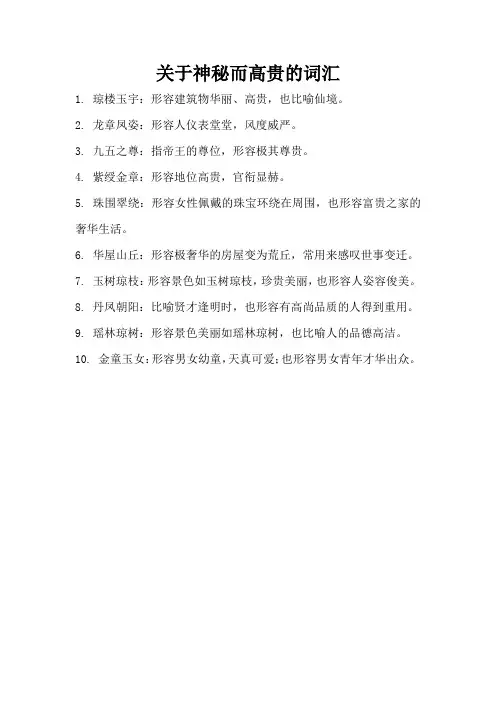
关于神秘而高贵的词汇
1. 琼楼玉宇:形容建筑物华丽、高贵,也比喻仙境。
2. 龙章凤姿:形容人仪表堂堂,风度威严。
3. 九五之尊:指帝王的尊位,形容极其尊贵。
4. 紫绶金章:形容地位高贵,官衔显赫。
5. 珠围翠绕:形容女性佩戴的珠宝环绕在周围,也形容富贵之家的奢华生活。
6. 华屋山丘:形容极奢华的房屋变为荒丘,常用来感叹世事变迁。
7. 玉树琼枝:形容景色如玉树琼枝,珍贵美丽,也形容人姿容俊美。
8. 丹凤朝阳:比喻贤才逢明时,也形容有高尚品质的人得到重用。
9. 瑶林琼树:形容景色美丽如瑶林琼树,也比喻人的品德高洁。
10. 金童玉女:形容男女幼童,天真可爱;也形容男女青年才华出众。
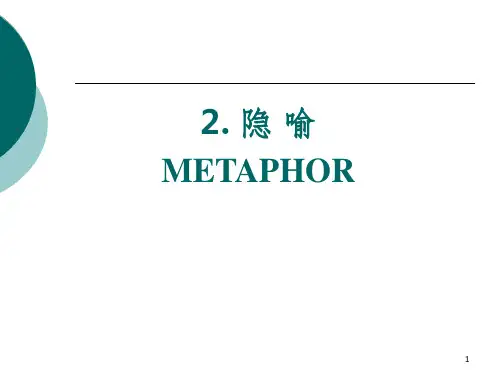
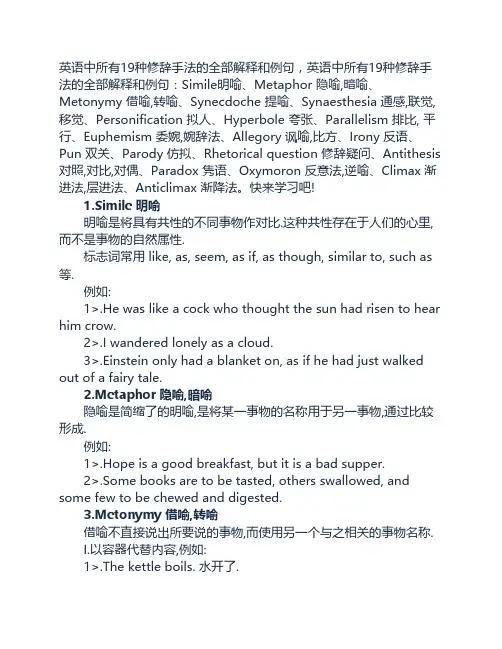
英语中所有19种修辞手法的全部解释和例句,英语中所有19种修辞手法的全部解释和例句:Simile明喻、Metaphor 隐喻,暗喻、Metonymy 借喻,转喻、Synecdoche 提喻、Synaesthesia 通感,联觉,移觉、Personification 拟人、Hyperbole 夸张、Parallelism 排比, 平行、Euphemism 委婉,婉辞法、Allegory 讽喻,比方、Irony 反语、Pun 双关、Parody 仿拟、Rhetorical question 修辞疑问、Antithesis 对照,对比,对偶、Paradox 隽语、Oxymoron 反意法,逆喻、Climax 渐进法,层进法、Anticlimax 渐降法。
快来学习吧! 1.Simile 明喻 明喻是将具有共性的不同事物作对比.这种共性存在于人们的心里,而不是事物的自然属性. 标志词常用 like, as, seem, as if, as though, similar to, such as 等. 例如: 1>.He was like a cock who thought the sun had risen to hear him crow. 2>.I wandered lonely as a cloud. 3>.Einstein only had a blanket on, as if he had just walked out of a fairy tale. 2.Metaphor 隐喻,暗喻 隐喻是简缩了的明喻,是将某一事物的名称用于另一事物,通过比较形成. 例如: 1>.Hope is a good breakfast, but it is a bad supper. 2>.Some books are to be tasted, others swallowed, and some few to be chewed and digested. 3.Metonymy 借喻,转喻 借喻不直接说出所要说的事物,而使用另一个与之相关的事物名称. I.以容器代替内容,例如: 1>.The kettle boils. 水开了. 2>.The room sat silent. 全屋人安静地坐着. II.以资料.工具代替事物的名称,例如: Lend me your ears, please. 请听我说. III.以作者代替作品,例如: a complete Shakespeare 莎士比亚全集 VI.以具体事物代替抽象概念,例如: I had the muscle, and they made money out of it. 我有力气,他们就用我的力气赚钱. 4.Synecdoche 提喻 提喻用部分代替全体,或用全体代替部分,或特殊代替一般. 例如: 1>.There are about 100 hands working in his factory.(部分代整体) 他的厂里约有100名工人. 2>.He is the Newton of this century.(特殊代一般) 他是本世纪的牛顿. 3>.The fox goes very well with your cap.(整体代部分) 这狐皮围脖与你的帽子很相配. 5.Synaesthesia 通感,联觉,移觉 这种修辞法是以视.听.触.嗅.味等感觉直接描写事物.通感就是把不同感官的感觉沟通起来,借联想引起感觉转移,“以感觉写感觉”。
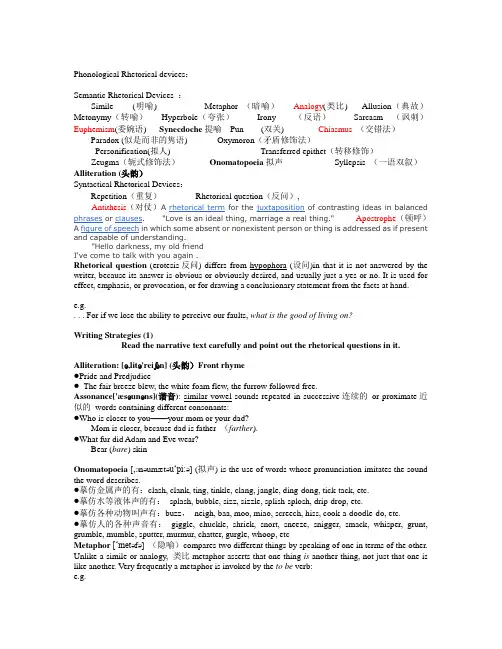
Phonological Rhetorical devices:Semantic Rhetorical Devices :Simile (明喻) Metaphor (暗喻)Analogy(类比) Allusion(典故)Metonymy(转喻)Hyperbole(夸张)Irony (反语)Sarcasm (讽刺)Euphemism(委婉语) Synecdoche提喻Pun (双关) Chiasmus (交错法)Paradox (似是而非的隽语) Oxymoron(矛盾修饰法)Personification(拟人) Transferred epithet(转移修饰)Zeugma(轭式修饰法)Onomatopoeia拟声Syllepsis (一语双叙)Alliteration(头韵)Syntactical Rhetorical Devices:Repetition(重复)Rhetorical question(反问),Antithesis(对仗)A rhetorical term for the juxtaposition of contrasting ideas in balanced phrases or clauses."Love is an ideal thing, marriage a real thing."Apostrophe(顿呼)A figure of speech in which some absent or nonexistent person or thing is addressed as if present and capable of understanding."Hello darkness, my old friendI've come to talk with you again .Rhetorical question (erotesis反问) differs from hypophora (设问)in that it is not answered by the writer, because its answer is obvious or obviously desired, and usually just a yes or no. It is used for effect, emphasis, or provocation, or for drawing a conclusionary statement from the facts at hand.e.g.. . . For if we lose the ability to perceive our faults, what is the good of living on?Writing Strategies (1)Read the narrative text carefully and point out the rhetorical questions in it. Alliteration: [ə,litə'reiʃən](头韵)Front rhyme●Pride and Predjudice●The fair breeze blew, the white foam flew, the furrow followed free.Assonance['æsəunəns](谐音): similar vowel sounds repeated in successive连续的or proximate近似的words containing different consonants:●Who is closer to you——your mom or your dad?Mom is closer, because dad is father (farther).●What fur did Adam and Eve wear?Bear (bare) skinOnomatopoeia [,ɔnəumætəu‘pi:ə] (拟声) is the use of words whose pronunciation imitates the sound the word describes.●摹仿金属声的有:clash, clank, ting, tinkle, clang, jangle, ding-dong, tick-tack, etc.●摹仿水等液体声的有:splash, bubble, sizz, sizzle, splish-splosh, drip-drop, etc.●摹仿各种动物叫声有:buzz,neigh, baa, moo, miao, screech, hiss, cook-a-doodle-do, etc.●摹仿人的各种声音有:giggle, chuckle, shriek, snort, sneeze, snigger, smack, whisper, grunt, grumble, mumble, sputter, murmur, chatter, gurgle, whoop, etcMetaphor [‘metəfə] (隐喻)compares two different things by speaking of one in terms of the other. Unlike a simile or analogy, 类比metaphor asserts that one thing is another thing, not just that one is like another. Very frequently a metaphor is invoked by the to be verb:e.g.●Then Jesus declared, "I am the bread of life.“●The fountain of knowledge will dry up unless it is continuously replenished by streams of new learning.●When it comes to midterms, it's kill or be killed. Let's go in and slay this test.Personification metaphorically represents an animal or inanimate object as having human attributes--attributes of form, character, feelings, behavior, and so on. Ideas and abstractions can also be personified.e.g.●The ship began to creak and protest as it struggledagainst the rising sea.Metonymy [mi‘tɔnimi] (转喻)is another form of metaphor, very similar to synecdoche (and, in fact, some rhetoricians do not distinguish between the two), in which the thing chosen for the metaphorical image is closely associated with (but not an actual part of) the subject with which it is to be compared.e.g.●The orders came directly from the White House.●This land belongs to the crown.●Boy, I'm dying from the heat. Just look how the mercury is rising. 有联系,但不是其一部分Synecdoche[si‘nekdəki] (提喻)is a type of metaphor in which the part stands for the whole, the whole for a part, the genus for the species, the species for the genus, the material for the thing made, or in short, any portion, section, or main quality for the whole or the thing itself (or vice versa).e.g.●Farmer Jones has two hundred head of cattle and three hired hands.●If I had some wheels, I'd put on my best threads and ask for Jane's hand in marriage.●Australia beat Canada at cricket. 局部代替全部A transferred epithet (转移修饰)is an adjective modifying a noun which it does not normally modify, but which makes figurative sense:e.g.●She gave us an understanding smile .●I spent sleepless nights on my project.Sarcasm 讽刺& Irony反语●Robbing a widow of her savings was certainly a noble act.Irony反语用词语表达与它们的字面意思相异或相反的用法●laws are like cobwebs, which may catch small flies, but let wasps break through.Sarcam是指用尖酸刻薄的话对个人的缺点、过失、社会的丑恶现象或黑暗面进行讥讽、挖苦,常是有意地伤害他人的感情,所以常含有较强的贬义。
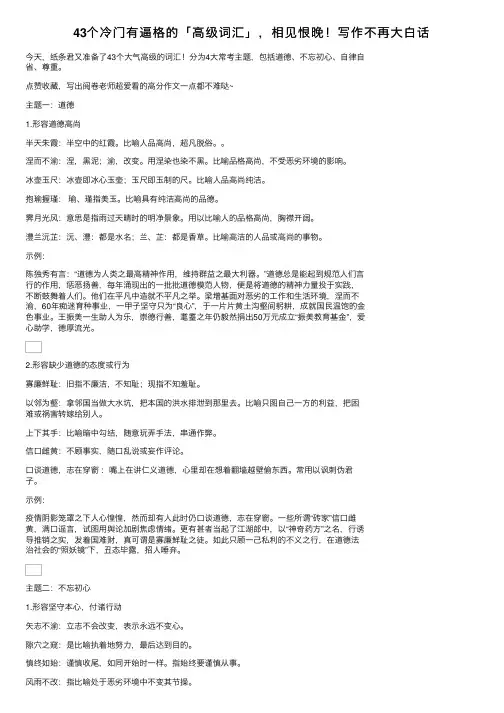
43个冷门有逼格的「⾼级词汇」,相见恨晚!写作不再⼤⽩话今天,纸条君⼜准备了43个⼤⽓⾼级的词汇!分为4⼤常考主题,包括道德、不忘初⼼、⾃律⾃省、尊重。
点赞收藏,写出阅卷⽼师超爱看的⾼分作⽂⼀点都不难哒~主题⼀:道德1.形容道德⾼尚半天朱霞:半空中的红霞。
⽐喻⼈品⾼尚,超凡脱俗。
涅⽽不渝:涅,⿊泥;渝,改变。
⽤涅染也染不⿊。
⽐喻品格⾼尚,不受恶劣环境的影响。
冰壶⽟尺:冰壶即冰⼼⽟壶;⽟尺即⽟制的尺。
⽐喻⼈品⾼尚纯洁。
抱瑜握瑾:瑜、瑾指美⽟。
⽐喻具有纯洁⾼尚的品德。
霁⽉光风:意思是指⾬过天晴时的明净景象。
⽤以⽐喻⼈的品格⾼尚,胸襟开阔。
澧兰沅芷:沅、澧:都是⽔名;兰、芷:都是⾹草。
⽐喻⾼洁的⼈品或⾼尚的事物。
⽰例:陈独秀有⾔:“道德为⼈类之最⾼精神作⽤,维持群益之最⼤利器。
”道德总是能起到规范⼈们⾔⾏的作⽤,惩恶扬善,每年涌现出的⼀批批道德模范⼈物,便是将道德的精神⼒量投于实践,不断⿎舞着⼈们。
他们在平凡中造就不平凡之举。
梁增基⾯对恶劣的⼯作和⽣活环境,涅⽽不渝,60年痴迷育种事业,⼀甲⼦坚守只为“良⼼”,于⼀⽚⽚黄⼟沟壑间躬耕,成就国民温饱的⾦⾊事业。
王振美⼀⽣助⼈为乐,崇德⾏善,耄耋之年仍毅然捐出50万元成⽴“振美教育基⾦”,爱⼼助学,德厚流光。
2.形容缺少道德的态度或⾏为寡廉鲜耻:旧指不廉洁,不知耻;现指不知羞耻。
以邻为壑:拿邻国当做⼤⽔坑,把本国的洪⽔排泄到那⾥去。
⽐喻只图⾃⼰⼀⽅的利益,把困难或祸害转嫁给别⼈。
上下其⼿:⽐喻暗中勾结,随意玩弄⼿法,串通作弊。
信⼝雌黄:不顾事实,随⼝乱说或妄作评论。
⼝谈道德,志在穿窬:嘴上在讲仁义道德,⼼⾥却在想着翻墙越壁偷东西。
常⽤以讽刺伪君⼦。
⽰例:疫情阴影笼罩之下⼈⼼惶惶,然⽽却有⼈此时仍⼝谈道德,志在穿窬。
⼀些所谓“砖家”信⼝雌黄,满⼝谣⾔,试图⽤舆论加剧焦虑情绪。
更有甚者当起了江湖郎中,以“神奇药⽅”之名,⾏诱导推销之实,发着国难财,真可谓是寡廉鲜耻之徒。
36个一眼惊艳的「高级词汇」5大常考主题,太仙了!作文满分的学霸都在用36个大气高级的词汇分为5大常考主题,包括追逐梦想、青春成长、成功与坚持、文化传统。
主题一:追逐梦想邈若山河:形容遥远得如隔山河。
可以描写理想的目标很远,需要自己努力去靠近。
空花阳焰:日光中浮动的烟尘,比喻不切实际的想法。
驰高骛远:不切合实际地追求过高过远的目标。
澄思渺虑:深思远虑。
可以描写对自己的梦想经过深思熟虑。
清明在躬:形容人的心地光明正大,头脑清晰明辨。
灿若繁星:如天上众多灿烂的星星,比喻才能出众的人很多。
云霄奋翼:比喻在高位施展才能,实现抱负鸿鹄之志:鸿鹄意为天鹅,志是志向的意思,比喻远大志向。
质朴无华:朴实而毫不虚夸,出自于林语堂《萧伯纳一席谈》。
空花阳焰:空花意为虚幻之花,阳焰是日光中浮动的烟尘。
比喻不切实际的想法。
解读:“梦想”是一个内涵丰富、模糊不定的词,具有很强的开放性。
当对这个抽象的概念进行直接描写的时候,我们可以拓展思路,从大与小、多与少、正与反等不同方面切入,用形象、精当的词汇加以描述,使文章角度更丰富。
示例:纵观古今,“梦想”一词依据时代变化、个人异同而各色各样,但无论是宏伟远大的鸿鹄之志,还是质朴无华的小小目标,都需要人们付出脚踏实地的努力,否则将永远只是空花阳焰。
主题二:青春成长夭矫如龙:意为形容姿态的伸展屈曲而有气势。
倥偬岁月:年少的时光转瞬即逝。
鲜衣怒马:字面意为鲜艳的衣裳,高大威武的骏马。
用来形容意气风发的少年英雄,或年少轻狂志得意满的纵马好时光。
怅然若失:指心情沮丧,像丢了什么东西。
形容心情失落的样子。
夭桃秾李:比喻年少美貌。
多用为对人婚娶的颂辞。
少不经事:没有经历过什么事情。
指经验不多。
秾华如梦:美好的事物很虚幻,不长久。
白发青衫:年老而功名未就。
振翮(hé)高飞:指拍打着翅膀向上飞行。
常用来形容人志向远大、努力奋发向上。
富于春秋:指年少,年轻。
解读:在议论和表达我们对青春的思考和感悟时,可以用一些更婉约清新的词汇去润色,不时用各种典雅的词汇代替“青春”二字,也可以用相反的词,提升文化气质。
1. 明喻(simile)是用like, as, as...as, as if(though) 或用其他词语指出两个不同事物的相似之处。
例如:(1)O my love's like a red, red rose. 我的爱人像一朵红红的玫瑰花。
(2)He jumped as if he had been stung.他像被蜇了似的跳了起来。
(3)The man can't be trusted. He is as slippery as an eel. 那个人不可信赖。
他像鳗鱼一样狡猾。
as long as it′s broad半斤八两;结果一样as clear as crystal清如水晶2. 暗喻/隐喻(metaphor)这种比喻不通过比喻词进行,而是直接将用事物当作乙事物来描写,甲乙两事物之间的联系和相似之处是暗含的。
(1)He has a heart of stone. 他有一颗铁石心肠。
(2)The world is a stage. 世界是一个大舞台。
(3)The diamond department was the heart and center of the store.钻石部是商店的心脏和核心。
英语中有许多数词习语和俚语,主要用作隐喻(也有个别用作明喻)。
(1)A hundred to one it will be a failure.这件事极可能失败。
(2)He has one over the eight.他酩酊大醉。
to teach fish to swim班门弄斧to plough the sand白费力气a square peg in a roun d hole不适宜担任某一职务的人between the devil and the deep sea进退两难。
3. 提喻(synecdoche)主要特点是局部代表全体,或以全体喻指部分;或以抽象代具体,或以具体代抽象;以特殊代表一般,或用一般代表特殊。
高级的汉语词汇
以下是 8 条相关内容:
1. “缱绻”——哎呀呀,那两人之间的感情可真是缱绻啊!就好像相
互缠绕的藤蔓,怎么也分不开。
比如说:“他们俩在夕阳下相互依偎,那缱绻的模样真是让人羡慕。
”
2. “氤氲”——哇哦,这山间的雾气好浓郁,真是一片氤氲之景呀!就如
同梦幻的薄纱。
像这样:“清晨的湖面笼罩着一层氤氲,仿佛进入了仙境一般。
”
3. “莞尔”——嘿,她听到那个笑话后莞尔一笑,哎呀,那笑容可真美!
就好像春天绽放的花朵。
比如:“他讲完故事,她不禁莞尔,那感觉真温馨。
”
4. “荏苒”——时间过得可真快呀,真是荏苒啊!就像那飞逝的流星。
可
以说:“岁月荏苒,我们都不再是当初的少年了。
”
5. “觊觎”——哼,那个人老是觊觎别人的东西,真不地道!就跟那贪婪
的饿狼似的。
例如:“他总是觊觎同事的成果,太让人讨厌了。
”
6. “睥睨”——哇,他站在那高高在上睥睨众人的样子,是不是太骄傲啦?就好比那不可一世的老鹰。
像这样:“他以睥睨的眼神看着对手,仿佛胜券在握。
”
7. “逶迤”——看那山脉多逶迤呀,好壮观啊!如同蜿蜒盘旋的巨龙。
比如:“长城在山间逶迤,展现着它的雄伟气魄。
”
8. “诙谐”——哈哈,他说话可真诙谐,太有趣啦!就像一个幽默大师。
可以说:“他的表演诙谐幽默,逗得大家哈哈大笑。
”
我觉得这些高级的汉语词汇真的很有意思呀,能让我们的表达更加丰富、生动呢!。
英语写作常用修辞手法英语中的修辞与汉语的修辞相比,分类细,种类多.下面将英语的修辞简单介绍如下:1.Simile 明喻明喻是将具有共性的不同事物作对比.这种共性存在于人们的心里,而不是事物的自然属性.标志词常用like, as, seem, as if, as though, similar to, such as等.例如:1>.He was like a cock who thought the sun had risen to hear him crow.2>.I wandered lonely as c cloud.3>.Einstein only had a blanket on, as if he had just walked out of a fairy tale.2.Metaphor 隐喻,暗喻隐喻是简缩了的明喻,是将某一事物的名称用于另一事物,通过比较形成.例如:1>.Hope is a good breakfast, but it is a bad supper.2>.Some books are to be tasted, others swallowed, and some few to be chewed and digested.3.Metonymy 借喻,转喻借喻不直接说出所要说的事物,而使用另一个与之相关的事物名称.I.以容器代替内容,例如:1>.The kettle boils. 水开了.2>.The room sat silent. 全屋人安静地坐着.II.以资料.工具代替事物的名称,例如:Lend me your ears, please. 请听我说.III.以作者代替作品,例如:a complete Shakespeare 莎士比亚全集VI.以具体事物代替抽象概念,例如:I had the muscle, and they made money out of it.我有力气,他们就用我的力气赚钱.4.Synecdoche 提喻提喻用部分代替全体,或用全体代替部分,或特殊代替一般.例如:1>.There are about 100 hands working in his factory.他的厂里约有100名工人.2>.He is the Newton of this century.他是本世纪的牛顿.3>.The fox goes very well with your cap.这狐皮围脖与你的帽子很相配.5.Synaesthesia 通感,联觉,移觉这种修辞法是以视.听.触.嗅.味等感觉直接描写事物.例如:1>.The birds sat upon a tree and poured forth their lily like voice.鸟儿落在树上,倾泻出百合花似的声音.2>.Taste the music of Mozart.品尝Mozart的音乐.6.Personification 拟人拟人是把生命赋予无生命的事物.例如:1>.The night gently lays her hand at our fevered heads.2>.I was very happy and could hear the birds singing in the woods.7.Hyperbole 夸张夸张是以言过其实的说法表达强调的目的.它可以加强语势,增加表达效果..例如:1>.I beg a thousand pardons.2>.Love you. You are the whole world to me, and the moon and the stars.3>.When she heard the bad news, a river of tears poured out.8.Parallelism 排比, 平行这种修辞法是把两个或两个以上的结构大体相同或相似,意思相关,语气一致的短语.句子排列成串,形成一个整体.例如:1>.No one can be perfectly free till all are free; no one can be perfectly moral till all are moral; no one can be perfectly happy till all are happy.2>.In the days when all these things are to be answered for, I summon you and yours, to the last of your bad race, to answer for them. In the days when all these things are to be answered for, I summon your brother, the worst of your bad race, to answer for them separately.9.Euphemism 委婉,婉辞法婉辞法指用委婉,文雅的方法表达粗恶,避讳的话.例如:1>.He is out visiting the necessary.他出去方便一下.2>.His relation with his wife has not been fortunate.他与妻子关系不融洽.3>.Deng Xiaoping passed away in 1997.10.Allegory 讽喻,比方这是一种源于希腊文的修辞法,意为"换个方式的说法".它是一种形象的描述,具有双重性,表层含义与真正意味的是两回事.例如:1>.Make the hay while the sun shines.2>.It's time to turn plough into sword.11.Irony 反语反语指用相反意义的词来表达意思的作文方式.如在指责过失.错误时,用赞同过失的说法,而在表扬时,则近乎责难的说法.例如:1>.It would be a fine thing indeed not knowing what time it was in the morning.2>"Of course, you only carry large notes, no small change on you. "the waiter said to the beggar.12.Pun 双关双关就是用一个词在句子中的双重含义,借题发挥.作出多种解释,旁敲侧击,从而达到意想不到的幽默.滑稽效果.它主要以相似的词形.词意和谐音的方式出现.例如:1>.She is too low for a high praise, too brown for a fair praise and too little for a great praise.2>.An ambassador is an honest man who lies abroad for the good of his country.3>.If we don't hang together, we shall hang separately.13.Parody 仿拟这是一种模仿名言.警句.谚语,改动其中部分词语,从而使其产生新意的修辞.例如:1>.Rome was not built in a day, nor in a year.2>.A friend in need is a friend to be avoided.3>.If you give a girl an inch nowadays she will make address of it.14.Rhetorical question 修辞疑问它与疑问句的不同在于它并不以得到答复为目的,而是以疑问为手段,取得修辞上的效果,其特点是:肯定问句表示强烈否定,而否定问句表示强烈的肯定.它的答案往往是不言而喻的.例如:1>.How was it possible to walk for an hour through the woods and see nothing worth of note?2>.Shall we allow those untruths to go unanswered?15.Antithesis 对照,对比,对偶这种修辞指将意义完全相反的语句排在一起对比的一种修辞方法.例如:1>.Not that I loved Caeser less but that I loved Romemore.2>.You are staying; I am going.3>.Give me liberty, or give me death.16.Paradox 隽语这是一种貌似矛盾,但包含一定哲理的意味深长的说法,是一种矛盾修辞法..例如:1>.More haste, less speed.2>.The child is the father to the man.17.Oxymoron 反意法,逆喻这也是一种矛盾修辞法,用两种不相调和的特征形容一个事物,以不协调的搭配使读者领悟句中微妙的含义.例如:1>.No light, but rather darkness visible.2>.The state of this house is cheerless welcome.18.Climax 渐进法,层进法这种修辞是将一系列词语按照意念的大小.轻重.深浅.高低等逐层渐进,最后达到顶点.可以增强语势,逐渐加深读者印象.例如:1>.I am sorry, I am so sorry, I am so extremely sorry.2>.Eye had not seen nor ear heard, and nothing had touched his heart of stone.19.Anticlimax 渐降法与climax相反的一种修辞法,将一系列词语由大到小,由强到弱地排列.例如:1>.On his breast he wears his decorations, at his side a sword, on his feeta pair of boots.2>.The duties of a soldier are to protect his country and peel potatoes.3.Analogy: (类比)6) Understatement: (含蓄陈述)7) Euphemism: (委婉)18) Oxymoron: (矛盾修饰)19) Antithesis: (对照)20) Epigram: (警句)。
有隐喻的英语单词The English language is a rich tapestry woven with words that carry layers of meaning beyond their surface. Some words are like 'anchors,' grounding us in the depths of their historical significance. Others are 'lenses,' offering us a new perspective on the world.Consider the word 'butterfly,' which flutters through our conversations, symbolizing transformation and change. It's a delicate creature that, in its flight, stirs the air of our metaphors, reminding us of the beauty in metamorphosis.'Seed' is another such word, a tiny package of potential, waiting to sprout into something greater. It's a reminderthat even the most significant beginnings are often small and unassuming.'Mirror' reflects not just our image but also our thoughts and feelings. It's a metaphor for introspection, inviting us to look deeper into ourselves and see what we truly are.'Catalyst' is a word that speaks of action and reaction. It's the spark that ignites change, the force that accelerates the process of transformation.'Echo' is a word that resonates with the idea of repetition and reverberation. It's a sound that bounces backto us, a reminder that our words and actions can have alasting impact.'Tide' is a powerful metaphor for the ebb and flow oflife. It's a constant reminder that change is inevitable, and with it comes the possibility of renewal.'Mosaic' is a word that speaks to the beauty of diversity. It's a collection of small pieces that, when put together,form a larger, more intricate picture.'Braid' is a metaphor for the intertwining of lives and experiences. It's a reminder that our individual strands,when woven together, create a stronger and more intricate pattern.In the English lexicon, every word is a story waiting to be told, a metaphor waiting to be discovered. These words are not just tools for communication; they are the threads that weave the fabric of our understanding.。
aid in healing 帮助治疗
anchor 心锚
associative thinking 联想式思维(状态)auditory eye position 听觉化眼神位置beyond conscious mind 超意识
censor 潜意识压迫力
certified master practitioner 注册高级执行师cloak 披风、斗篷
coach position 教练位置
color exercise 填色练习
communal 集体的、社群的
conciousness metaphor 意识隐喻
counsellor 咨询师
deep metaphor 深度隐喻
dissociate 抽离
dissociation anchor 脱离心锚
dissolving 消溶的
doze 打瞌睡
dream decipher [diˈsaifə] 梦的解析
dream interpretation 梦境解析
dream slides 梦的定格画面
embodied experience 经验具象化
enlightment 启示
facilitator 协助者、推进者
feeling gauge 感觉衡量器
fresh dream 首次出现的梦境
gauge [geidʒ]测量仪器、衡量标准hologrammatic structure 全息结构
hooded 戴头巾的
insight 领悟
instinctual brain constriction 本能的脑部紧张integration chair 整合椅
interact 相互影响、相互作用
intuition 直觉
intuition chair 直觉椅
kinesthetic 感觉的、动觉的
lanuaging-cognitive function 语言认知功能level eyes 眼神平视
logical level sequence 逻辑层次顺序microscope metaphor 微观隐喻
morphogenetic brain 形态发生脑
musical chair 音乐椅
new lines of action 新行为
on the right track 做得对
outcome frame 成果框架
perception 感知
peripheral sound 边缘声音peripheral vision 边缘视觉problem state 有问题的精神状态program 设计
recurring dream 重复出现的梦境shadowy figure 黑影
swish 闪变
symbolic image 象征影像
three chairs method 三椅法
three column system 三栏系统timelessness 无时间性unconscious mind 潜意识、潜意识脑visual position 视觉化位置。